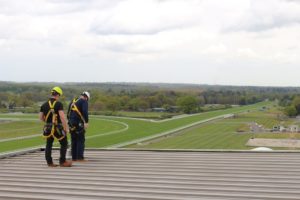Working at height
Stricter work at height regulation may be the only way to stop avoidable deaths
From 2013-18, falls from height accounted for the majority of fatal injuries to workers – at an average of 37 deaths every year. It is a major killer of workers in key sectors including construction and agriculture, and the figures show no sign of improvement, as Ken Diable, Managing Director at Heightsafe, explains.

Ken Diable Managing Director of Heightsafe
The sad fact is that many of these incidents are entirely preventable. Whether lack of planning, lack of equipment or cultural complacency, there continues to be a tide of prosecutions against organisations for poor Working at Height practices.
Last month the All-Party Parliamentary Group (APPG)’s report on Working at Height described how improving communication around existing regulation, advice and best practices could help mitigate these poor practices.
While communication campaigns are important in encouraging proactive safety cultures, I don’t believe this goes far enough. With the Healthy and Safety Executive (HSE) due to publish it’s latest 2019/20 Business Plan this quarter, now is the ideal time to have a frank discussion about the need for stricter legislation around Working at Height.
Safe working, why are so many missing a proactive culture?
Unfortunately, in our experience it often takes a near miss for organisational leaders to sit up and take action. In the aftermath they can often blame their health and safety (H&S) colleagues, rather than looking more widely at the top-down culture and investment.
We must not forget that H&S managers are dealing with a raft of risks. Where they do lose focus on the basics, it isn’t necessarily their fault. Rather, it may be a symptom of a wider culture in health and safety that often focuses on the latest ‘new’ issue, rather than returning to, and reinforcing the basic principles.
For example, in the HSE’s 2018/19 plan its priorities were around occupational lung disease, musculoskeletal disorders, and work-related stress. Despite falls from height accounting for the highest number of fatal injuries in the workplace, no mention was made of tackling this specific issue.
The concern is that in the drive to solve complex issues, the HSE may be losing strategic focus on making sure the basics are done right. These messages then filter down, with organisational focus shifting away from the foundations of safe working in order to firefight the issue of the moment.
Perhaps focus can only be reframed through regulatory change?
What will stronger Work at Height regulation achieve?
There are several ways in which regulation can play a part in stopping preventable deaths and life-changing injuries. From 2013-18 47% of deaths, and 33% of injuries in the construction industry were as a result of a fall from height.
The first is to ensure organisations take a proactive approach to planning for Working at Height by making the correct equipment a legal requirement.
Making Work at Height equipment a legal requirement on all new buildings and redevelopment projects, with a minimum standard set in building regulations would significantly impact on the downtrend for these entirely preventable incidents.
Of course, this would impact budgets and as such it would be sensible to also offer tax relief for businesses actively investing in Work at Height equipment to protect their personnel, similar to the Land Remediation Relief currently available in the asbestos industry.
Ensuring that the right safety equipment is available to workers should be seen as a basic requirement. Unfortunately, it often takes an incident or near-miss to spur action and investment in equipment. When lives are being put in jeopardy this is not a risk worth taking.
Benchmark competition and drive compliance
 Another way to drive down avoidable incidents would be for RIDDOR statistics to be easily accessible online for businesses in high-risk industries such as construction and agriculture. A certification scheme from RIDDOR, providing proof of an organisation’s accident statistics would allow comparison and benchmarking against competitors and peers.
Another way to drive down avoidable incidents would be for RIDDOR statistics to be easily accessible online for businesses in high-risk industries such as construction and agriculture. A certification scheme from RIDDOR, providing proof of an organisation’s accident statistics would allow comparison and benchmarking against competitors and peers.
Why is this important? The fatal injury rate in construction is around four times the all-industry rate. If the HSE were to continually monitor and report on the Health and Safety performance of contractors in high-risk industries, they could score contractors against set metrics to aid in a proactive approach. By providing an easy-to-check database clients themselves can have a greater role to play in improving safety culture. If clients demand it, suppliers will have to listen.
What can be done now to stop avoidable deaths and injuries?
The fact is that while debates are had over the best ways to deal with these avoidable incidents, people are still getting injured and lives ruined. Industry shouldn’t wait for regulators to come knocking before they act. Here’s what can be done right now:
- Training – The Work at Height Regulations 2005 state that as an employer or duty holder, you are required to ensure that all employees have access to Work at Height equipment that reflects the requirements and regulations, including training in the use of equipment.
- Fall Protection Systems – Current health and safety legislation dictates that Fall Protection systems should be in place when employees or contractors carry out work at height.
- Safe Equipment – Personal Protective Equipment (PPE) is a vital part of protecting against the risks posed whilst Working at Height. This includes items such as safety harnesses, lanyards and karabiners legally required when using some Personal Fall Protection systems. As an employer it is your duty to ensure that employees are fully trained when it comes to selecting the correct PPE for the job.
- Inspection, Testing and Compliance – The PUWER Regulations 1998 state that regular maintenance and testing of Work at Height equipment and PPE is required to remain compliant. If your systems are not visibly tagged and in compliance, it may not only invalidate your insurance, but could also lead to prosecution, should an employee, contractor or even trespassers suffer injuries.
Health and Safety practitioners are all driven by a desire to make work safe. As much as regulation may be seen as an additional burden, it should also be viewed as a tool to help focus business leaders on the need to support their H&S experts deliver the basics.
Stricter work at height regulation may be the only way to stop avoidable deaths
Falls from height is a major killer of workers in key sectors including construction and agriculture, and the figures show no sign of improvement, as Ken Diable, Managing Director at Heightsafe, explains.
Safety & Health Practitioner
SHP - Health and Safety News, Legislation, PPE, CPD and Resources Related Topics
Company fined after worker crushed to death
Horticulture company fined after lorry driver suffers life changing injuries
Director jailed for failing to protect workers from asbestos exposure


 Another way to drive down avoidable incidents would be for
Another way to drive down avoidable incidents would be for
Greater legislation is a folly. The current legislation and guidance is more than adequate. If people are going to carry out , and plan, unsafe work , they will continue to do so regardless of the level of legislation in place.
We have laws and legislation in place for all sorts of things. But people still break them. Murder for example!
This is a cultural matter, not a legislative matter.
Totally agree with your comments Scott, even such a comprehensive editorial such as this it still contains errors and misunderstandings ie the stupid reference to 2mtrs for example. I have spent the last 32 years of my life training height workers as a specialist discipline, The most frequent issue I find is a lack of Supervision NOT ONLY THIS BUT THOSE THAT ARE IN CONTROL have not actually recieved any INFORMATION, INSTRUCTION, TRAINING OR SUPERVISION. Over 85% of all ourtraining per year is carried out reactively, this is not ACCEPTABLE Legislation is only part of the remedial measures necessary EDUCATION… Read more »
I’m glad someone else picked up on the 2m nonsense!
Agreed, legislation is only effective if people
a) are aware of it and
b) are minded / supervised to comply
This piece is about wanting to sell more kit, I feel.
What on earth would new legislation cover? Looking at the fatalities in the study, they varied across industry and activity, no real pattern, and as far as I can see, existing legislation is sufficient but was just not complied with.